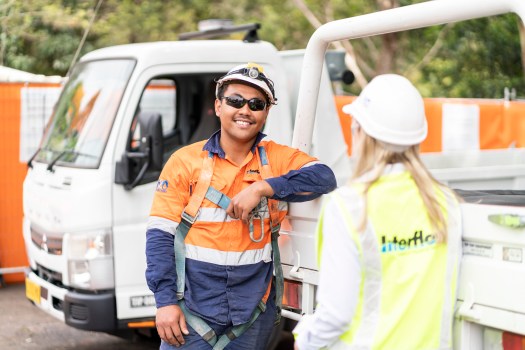With much of our water infrastructure due for renewal over the next decade, including asbestos cement pipes, there’s a need for a deep insight into asset conditions and failure mechanisms, and a collaborative approach to solutions.

Much has been made of the infrastructure cliff identified in Infrastructure Australia’s Australian Infrastructure Audit 2019. The report highlighted the fact that as water assets reach the end of their service life, the cost of renewal could overwhelm water authorities and their ability to meet the expectations of customers.
Since then, innovation and advancement has been occurring at pace in some parts of the sector. But innovation alone isn’t always beneficial, and often doesn’t solve underlying problems.
“Companies will often bring new technologies to market seemingly without understanding the technical parameters around how they may need to perform,” says Will Zillman, national product manager at pipeline infrastructure solutions provider Interflow.
Mr Zillman says these products are oftern sold into the market without a proper understanding of the actual benefits and risks.
“For example, a lot of newly marketed pipe-renewal technologies leave existing service connections in place, rather than replacing them. Those connections are typically the same age as the host pipe,” he says.
“If you’re replacing or renewing only the host pipe, it’s probably not long before those connections fail, too.
“Compare that to our RediFlow technology, where we go in and renew all of those connections at the same time as we renew the pipes. It means, for argument’s sake, that two years down the track you’re not coming back to the same customer group and giving them more grief because you have to dig again.”
But what about the root cause? How does a water authority get to a stage where it can feel confident about avoiding the infrastructure cliff by planning a proactive series of renewals? Let’s use asbestos cement pipes as a case study.
Asbestos cement: A blessing and a curse
“Different failure mechanisms require different treatments,” Mr Zillmann says. “Asbestos cement (AC) pipes in general have an average service life of40 to70 years.
“Given that the last AC pipe was put in the ground in 1986 in Australia, we’re coming into a period in which a lot of these assets are going to be starting to show significant signs of failure.’
Obviously, there are many complications around the rehabilitation of AC pipes.
Pipebursting AC water mains is no longer seen as an acceptable practice. As soon as you run a bursting head through an AC pipe, for instance, it changes it from being non-friable to friable and becomes much more dangerous.

“You’re putting asbestos fibres into the ground around the hotspot, and that’s why the industry no longer allows pipe bursting of asbestos cement,” Mr Zillmann says.
“But if we dig it up and replace it, we’re taking asbestos from one location to another and increasing the amount of landfill with a highly dangerous product. We’re creating a problem for future generations.”
What’s the solution?
The fundamentals are the same for any type of pipe – it’s about developing a clear picture of the conditions and types of all of your existing assets and appreciating that they all have some form of value.
“As an industry, we don’t always look at things holistically and we’re often driven by short term budgets rather than matching budgets to solve the greater issues,” Mr Zillmann says.
“If a pipeline has had failures, we replace it. We see it as an isolated pipeline and attack the problem on a reactive basis. We don’t see that we’ve got this asset class that was installed in the same period of time, in that area, so they’ll all be at risk of failure.”
A holistic approach
A holistic approach to renewing a larger area reduces units cost and improves the long-term customer experience. It also means water pressures can be dialed back up if they have been reduced in the past to protect the infrastructure or reduce leakage.
In the case of AC pipes, a variety of trenched and trenchless techniques can be used to renew an entire service area, depending on the specific site and asset conditions, and the needs of water authorities and their customers.
Thorough knowledge of the condition of the entire network allows good and effective decisions to be made around these processes. Scheduling work into larger, planned blocks rather than reacting after a failure also helps in managing increasing customer, council and Department of Transport expectations. After all, work announced well in advance is a lot more acceptable than surprise disruptions.
The future is collaborative
Mr Zillmann says to achieve the greatest economic benefit and customer experience, a high degree of collaboration between vendor and customers is essential.
“With Interflow, if you bring us into the conversation around how you want to deliver service, or how you want to be innovative while removing risk, we can help,” he says.
“If there are working groups developing solutions to challenges, bring in contractors who are recognised industry experts. We will help solve the challenge.”
Since its inception in 1936, Interflow has carved out its place as a leader in pipeline infrastructure. Today, the company is regarded as Australia and New Zealand’s leading provider of trenchles pipeline solutions, developing innovative methods to extend the operational life of water networks across Australasia. Employing over 600 field crew and office-basedteam members, Interflow has completed works for major water authorities and government bodies in the watermains, wastewater, stormwater, and culvert sectors. Specialists in bothtrenchless technology as well as dig-and-replace methods, Interflow has offices in Sydney, Charmhaven, Canberra, Melbourne, Bendigo, Brisbane, Caboolture, Mackay, Adelaide, Perth, and Auckland, with headquarters in Girraween, NSW. Interflow serves the following industries: Water, Wastewater, Stormwater and Culverts. The company offers project planning, design, investigation and condition assessment, new construction, asset rehabilitation and renewal, periodic maintenance, and emergency services.
For further information, please visit www.interflow.com.au.





Leave a Reply